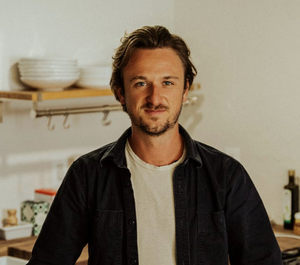I'm a daily coffee drinker, and nearly every time I brew up a cup I'm reminded of what an incredible and fascinating beverage it is.
Native to Ethiopia and thought to have been discovered by accident by goat farmers, it's now one of the most widely consumed beverages in the entire world. It's one of the most traded commodities on earth. It arguably powered the Enlightenment. And it's made functional addicts out of a large portion of the world's population. In other words, it's pretty powerful stuff.
For many people, coffee's flavor is something of an afterthought to its functional properties. But I'm here to convince you that you should take the time to discover the joy of great coffee.
At it's best, coffee is not just delicious but also endlessly interesting. There are more aromatic and flavor compounds in coffee than there are in wine. And like wine, there's incredible diversity and terroir to be found in different coffee varietals from different regions. When you explore great coffee, you get the opportunity not just to experience a range of interesting flavors, but also to hone in on the characteristics you like best. You'll learn how to select for different flavors, aromas, and levels of acidity, which will ultimately allow you to brew the perfect cup for you.
And importantly, great coffee doesn't have to be a chore. My morning coffee takes me less than 10 minutes start to finish, and it's a great way to kick off the day with a meditative, repeatable ritual.
In this guide, I'm going to show you exactly how to do it.
The Brew Style
There are a ton of ways to make coffee, from French press to flash-frozen capsules to Kyoto-style drippers that look like they belong in a Walter White laboratory. And ultimately, it does come down to personal preference.
I've tried nearly every type of coffee in the book, and for this guide I'm going to mostly focus on what I consider the indisputable king of coffee brewing— the pour-over method. Nothing compares in terms of flavor, filtration, and pure enjoyment.
My preferred method for making a pour-over coffee is the Chemex. It's well-designed, sturdy, and the Chemex filters are the best I've come across. That said, there are lots of ways to make a pour over– I've personally used the Hario v60 and the Kalita Wave, both of which are great. Find one whose design and price point you like, and purchase it along with a set of compatible filters.
Side note– if speed is your thing, my second-favorite way to brew coffee is with the Aeropress. It strikes the best balance between convenience and taste, and it makes it quick and easy to make one great cup of coffee. This video from Stumptown shows you exactly how to do it.
The Equipment
In addition to your brewer, you'll need a few pieces of equipment to get up and running.
Grinder
Hardcore coffee nerds will tell you that the grinder is the single most important piece of equipment you own, and they’re right. Ground coffee tends to oxidize pretty quickly, which makes pre-ground beans a no-go for serious connoisseurs. Grinding your coffee fresh each morning makes a huge difference.
If you're going to buy a new grinder, it makes sense to spend a bit more money and get a good one. You're looking for a burr grinder, which will get you a much more even grind than something that operates with blades.
My personal recommendation is the Baratza Encore. It’s very affordable given its quality, and it works great. But there are plenty of other options in different price ranges.
Kettle
To make a pour-over, you'll need what's known as a gooseneck kettle. You've likely seen these before– they have a long, thin spout that gives you much more precision when pouring water over your beans.
You don't have to break the bank on one of these– there are some perfectly suitable options that are very affordable.
Scale
Finally, you'll need a kitchen scale. The best coffee is made with a bit of precision, and this will help you know exactly what you're doing. This Etekcity scale costs less than $15, and I've had mine for years. Plus, everyone should own a kitchen scale anyways– they've very handy.
The Beans
Coffee goes through a multi-step process on its way from the farm to your cup. It's grown in hundreds of different regions around the world, bagged up in its green form, and then roasted. In most cases, you're buying from the roaster, rather than the farm itself.
The best roasters will source amazing beans from farmers all over the world. And the roasting process itself is incredibly important– it takes skill to tease out the best flavors and roast properly.
Coffee is a lot like wine– there are literally thousands of different regions and microclimates, and millions of individual farms. The flavor of the beans is going to be influenced by everything from the climate to the soil to the farming practices and the roast. While there are often general similarities between coffees from the same region, there's also a ton of diversity from batch to batch. My recommendation is simply to taste your coffee intently, pay attention to what you like, and then seek out coffees with similar notes.
The most important thing with beans is to buy them fresh and store them well. Ideally, you want to consume beans within a month of them having been roasted. Good coffee will always have a roast date on the bag. I recommend getting an airtight coffee container to store your beans, which will help a lot to keep them fresh.
If you've got a local roaster, try buying directly from them! If you prefer to buy online, a few of my favorites are below.
- Sey Coffee is probably my all-time favorite roaster. They consistently ship some of the best coffee I’ve ever had.
- Klatch Coffee is one I discovered recently. I love that they have 100% organic, single-origin options for both regular and decaf. They’re delicious, too.
- Modern Times is out of San Diego– their coffees are consistently delicious and they do some wild experiments with barrel-aging their beans.
- Frinj Coffee carries the only coffee grown in North America– it's very expensive but the flavor is incredible.
- Greater Goods is here in Austin, and that's where I buy a lot of my everyday beans.
- Savorista is my current go-to for decaf and half-caf beans.
Check out some shops, try some beans, and find what you like!
The Perfect Pour Over
Welcome to your new morning ritual.
Step 1: Heat Your Water
Fill up your gooseneck kettle with water and heat it to just boiling. As you wait for it to heat up, you can prep everything else.
Step 2: Weigh and Grind Your Beans
I find that the best coffee is made with a 15:1 ratio of water to coffee.
I use 20g of coffee (and 300g water) for mine every morning. That makes about 1 solid cup. Feel free to scale up depending on how much coffee you drink and how many people you're making it for.
Grind your beans to a medium-fine grind. Some grinders may have a pre-selected setting for pour over. You want them to look like the photo below.

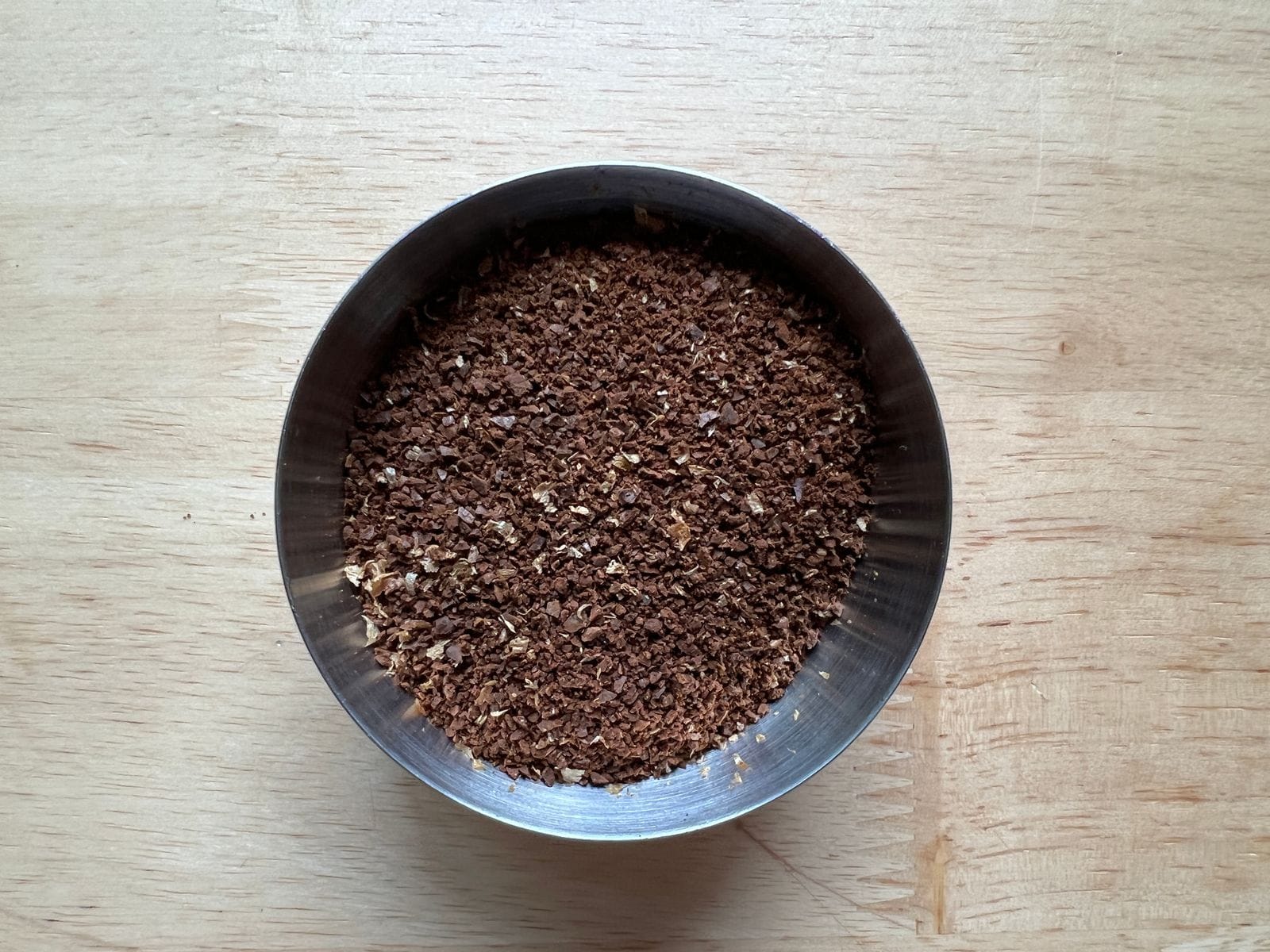
Step 3: Wet Your Filter
You always want to wet your filter with hot water before you add your coffee. This serves two purposes– it heats up the filter and the glass below it so that your coffee isn't dripping onto cold glass. And it gets rid of any "papery" taste you might get from the raw fiter.
Pour a bit of hot water over the filter, swirl it around in the glass below, and then dump it out.



Step 4: Add Your Grounds
Now, you can add your grounds directly over the filter. Give them a quick shake after you dump them in so that they sit in a flat layer.
Once you add your grounds, tare your scale to zero so that you can measure exactly how much water you add.


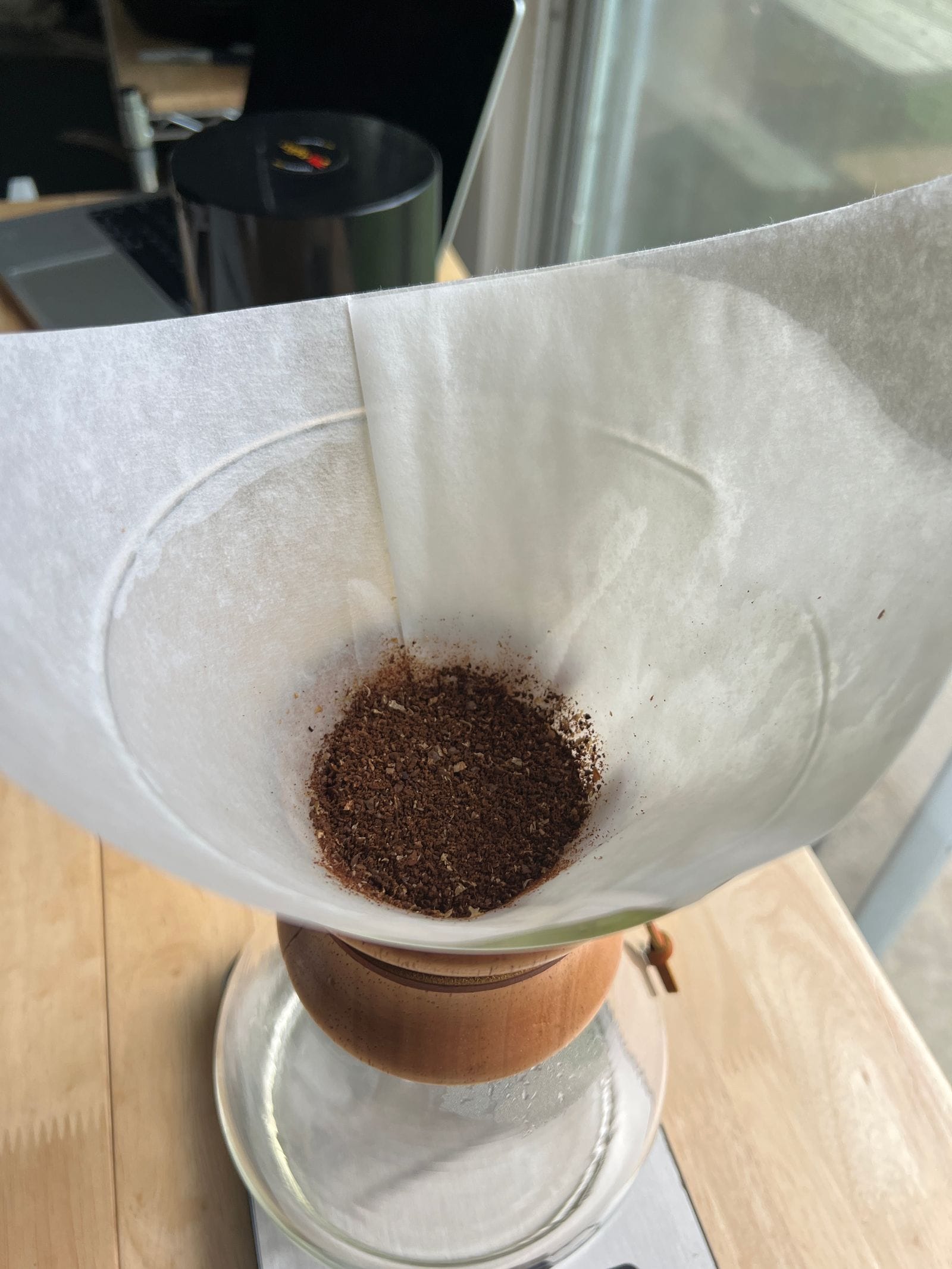
Step 5: Bloom the Coffee
"Blooming" your coffee refers to the process where you add just a bit of water to start things out. The coffee will immediately start to react to the heat and water, and will start to release gas and bubbles like the photo below.
This process serves to activate a lot of the flavor compounds, and it makes a big difference. If you drown it with a ton of water before it has a chance to bloom, it won't taste nearly as good.
To bloom, simply add about 50-60g of water to the grounds, aiming to cover the whole surface area. Then, give the coffee 30-60 seconds to bloom. You'll see the reaction happen immediately, especially with freshly roasted coffee.
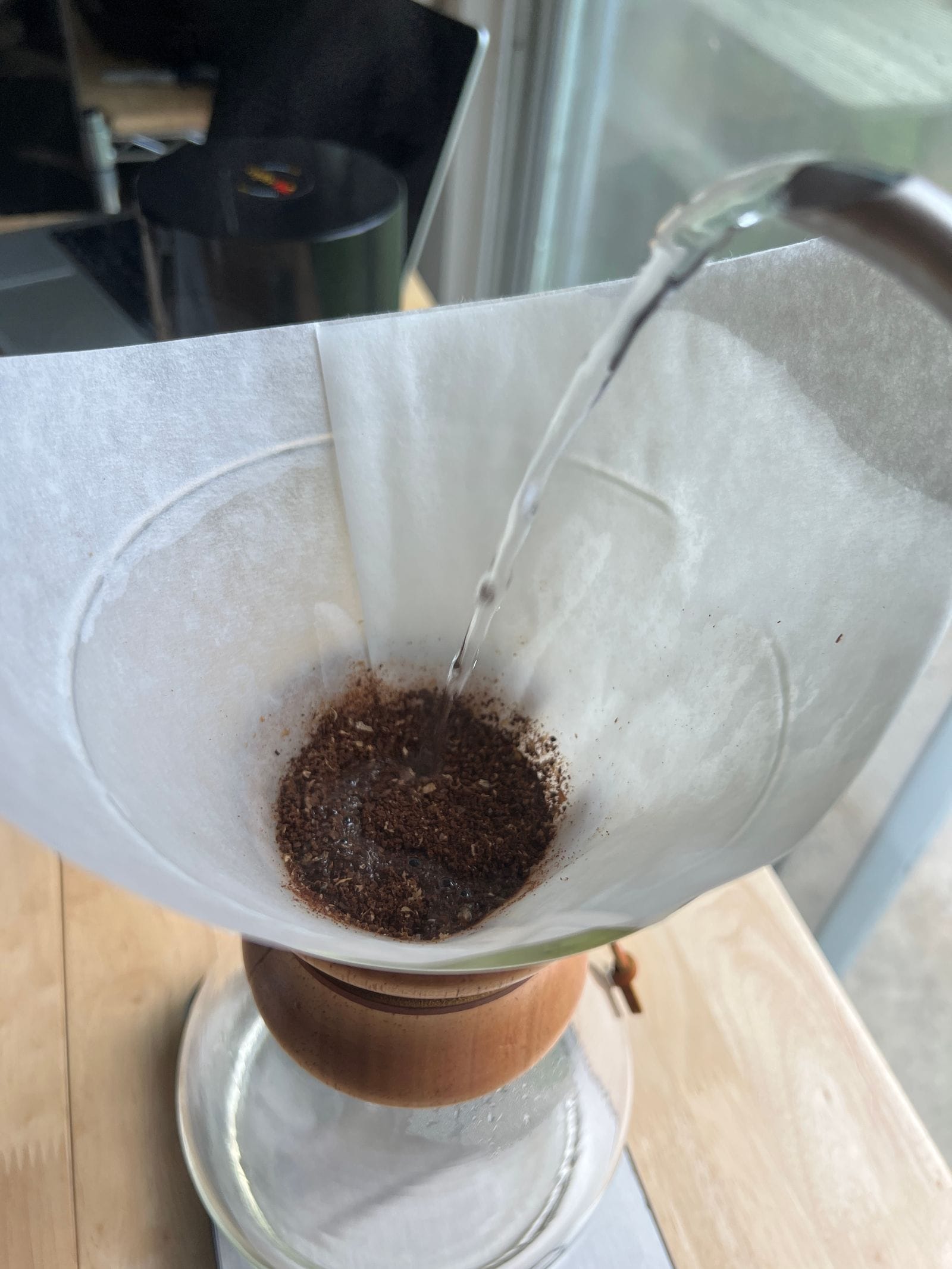

Step 6: Complete Your Pour
The final step is to complete your pour.
To do this, you want to start by zig-zagging across the surface of the coffee to cover the whole area. Then, slowly pour in concentric circles across the top until you reach your total amount of water.
Step 7: Enjoy
Once your coffee has finished steeping, simply remove the filter, give the coffee a quick swirl, and pour it into your cup. Now you're ready to enjoy a world-class cup of coffee.
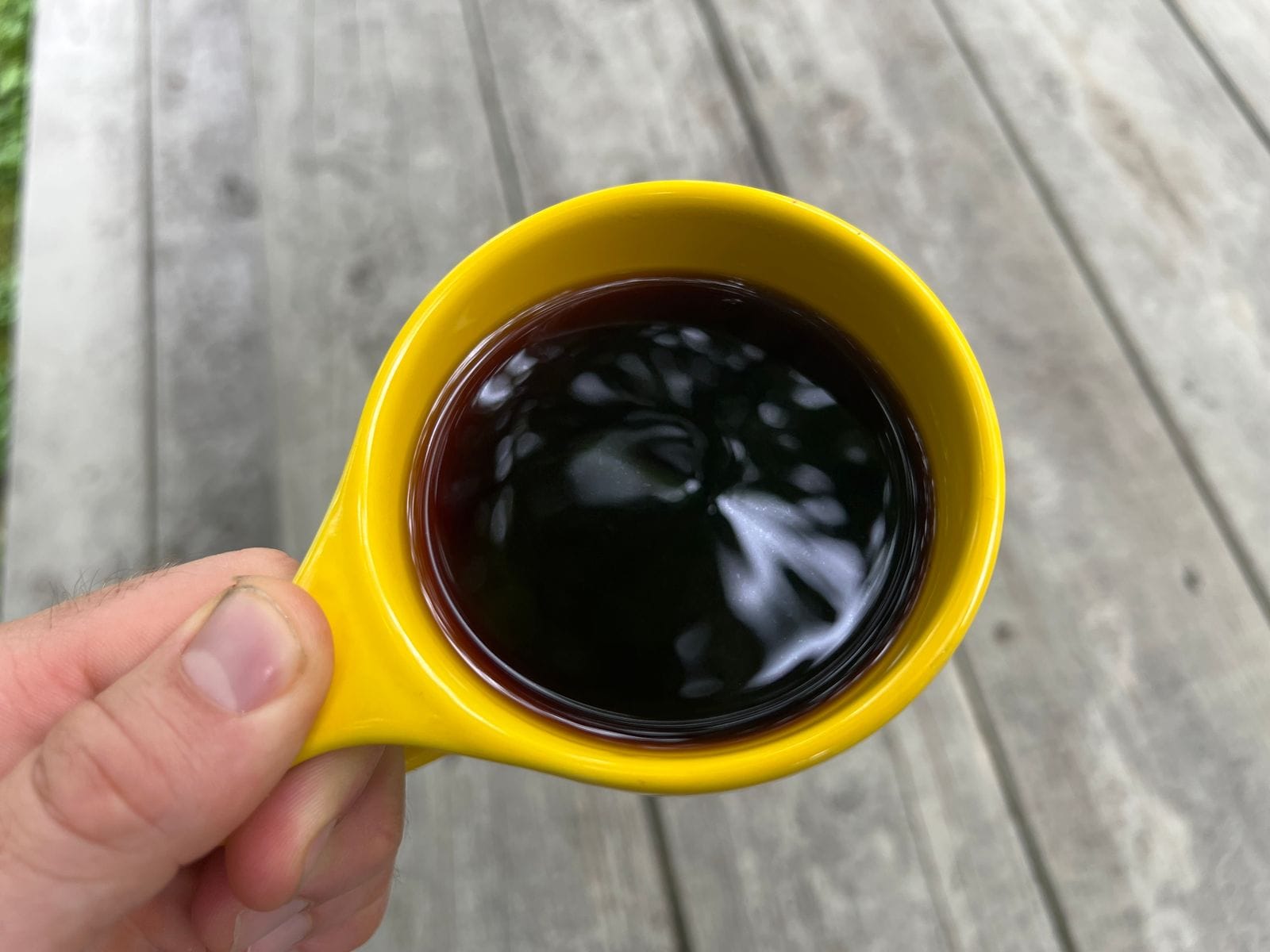
Cold Coffee
While I love almost nothing more than a piping hot cup of coffee, there are certainly times that call for something cold.
I've outlined my two favorite methods– cold brew and Japanese-style iced coffee– below.
Cold Brew
Cold brew is a way of making coffee where the entire extraction process involves no heat. Depending on who you ask, this has both benefits and downsides.
Some flavor and aromatic compounds in coffee are only activated by heat. Which means that cold brew won't necessarily bring out the best in certain types of coffee. There's a lot of nerdy science behind this, but generally speaking cold brew will highlight chocolately, nutty flavors in coffee. Coffees that lean acidic, floral, and fruity won't necessarily perform as well.
The solution to this is to select your beans properly. A lot of roasters will have cold brew blends that do this guesswork for you. My general rule of thumb is to make cold brew with coffees that naturally have notes of chocolate, nuts, and toffee. Regionally, these coffees tend to come from South and Central America. But you can also just look at descriptions online or ask your roaster.
Cold brew is super easy to make at home, and it's worth doing in a big batch. Click through to my Twitter thread below to see a step-by-step recipe for the whole process!
Japanese-Style Iced Coffee
Japanese-style iced coffee is another one of my favorites. Regular iced coffee often has an acrid, bitter taste to it because the hot coffee takes too long to cool down when poured over ice. To solve this problem, Japanese-style iced coffee is brewed hot (in a pour-over) and then immediately dripped onto ice to cool it down.
This style has the added benefit of bringing out some of the interesting flavors that you don't get in cold brew. This was a revelation when I discovered it, and it's still my favorite way to make cold coffee.
I outline the whole process in this Twitter thread. Check it out below:
Decaf and Half-Caf Coffee
Most decaf coffee is decaffeinated chemically with ethyl acetate. This should obviously be avoided.
Instead, you should look for decaf coffee that’s made using a water process, which just uses water, temperature, and time to remove caffeine. The most famous of these is called the Swiss Water Process, and there are a bunch of great roasters that sell coffee made this way.
Lately I’ve been enjoying Klatch Coffee’s single-origin organic Honduras decaf, as well as Savorista’s decaf and half-caf.
